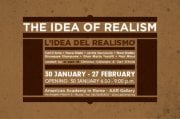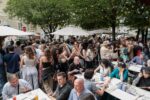The Idea of Realism

L’Idea del Realismo è un progetto a cura di Christian Caliandro e Carl D’Alvia, promosso dall’American Academy in Rome, nell’ambito di Cinque Mostre, una serie di mostre che si svolgeranno in contemporanea.
Comunicato stampa
La questione del realismo si è riposizionata negli ultimi mesi al centro dell’attenzione e del discorso pubblico: nel territorio dell’arte contemporanea, essa è ancora oggetto di fraintendimenti e sovrapposizioni concettuali. Le possibili declinazioni contemporanee e aggiornate del realismo – non uno stile, ma un tipo di approccio al mondo – è l’oggetto di questa proposta espositiva, che deriva dall'omonima serie di articoli pubblicati sulla rivista “Artribune” tra giugno e settembre 2012. L'Idea del Realismo (30 gennaio – 27 febbraio 2013), questo il titolo, è un progetto a cura di Christian Caliandro e Carl D'Alvia, promosso dall'American Academy in Rome, nell'ambito di Cinque Mostre, una serie di mostre che si svolgeranno in contemporanea.
La rappresentazione del reale è disinnescata, da troppo tempo, dalla stessa paura comune che dovrebbe scatenarla: è intrappolata tra l’evasione e la rimozione del disagio collettivo e individuale. Invece di tematizzare questo disagio, la cultura spettacolare continua a dedicarsi all’elaborazione della vita parallela attraverso la nostalgia (“i bei tempi andati”) e la consolazione (“vedete, non è poi così male”). Riscoprire il realismo significa adottare finalmente un punto di vista diametralmente opposto a quello che noi siamo abituati da anni a definire come ‘autoreferenzialità’, e che vuol dire sostanzialmente negare l’esistenza della realtà esterna (la società, la storia, l’immaginario, l’economia: la vita). Ciò che cambia radicalmente dunque, in un’ipotesi realista, è l’approccio, la ‘disposizione’ nei confronti del mondo: la fiducia nel fatto di comprenderlo, e che attraverso questa comprensione si possa produrre un cambiamento.
Gli artisti riuniti nella collettiva – quattro americani e tre italiani - articolano in modi differenti e personali questa disposizione verso la realtà. Carl D’Alvia lavora da anni sul confine sottile e sfumato tra realtà e rappresentazione, tra oggetto e simulazione, tra permanenza ed effimero, suggerendo nuovi effetti e stati di realtà. Nella pittura di Pesce Khete, invece, i materiali – pittorici, culturali, autobiografici - non collidono, ma si amalgamano e si condensano in una narrazione intima ed emotiva. Il mondo creativo di Nei Ritratti di Jackie Saccoccio, il risultato finale si regge sull’impressione di una testa umana, o di una massa centrale, ma tende a suggerire l’opposto - un vuoto, un sistema che sprofonda. Il mondo creativo di Ward Shelley è dominato dall’organizzazione gerarchica dei materiali: l’archivio potenzialmente infinito di informazioni, dati, nomi, fenomeni culturali, sequenze temporali, processi storici è il territorio che le sue infographic artistiche scelgono come zona d’azione e spazio d’intervento. Giuseppe Stampone porta avanti da anni il suo progetto Global Education: un’opera ambiziosa di ri-educazione collettiva, in cui gli spettatori vengono trasportati dal recinto (sicuro, protetto, sterilizzato) dell’arte contemporanea al “fuori” della realtà mediatizzata. L’opera di Gian Maria Tosatti è un continuo tentativo di agganciare e catturare il senso di sfuggente e indefinibile disagio che ci attraversa tutti, e che è la radice vera della contemporaneità, lo spirito di questo tempo. Infine, Nari Ward compone le sue installazioni collazionando e trasformando oggetti e materiali provenienti dallo spazio urbano.
***
The question of realism has re-positioned itself in recent months at the center of both the attention and the discourse of the public: in the territory of contemporary art, it is still an object of misunderstanding and conceptual superimpositions—not a style but a type of approach to the world—this is the focus of this exhibition, which derives from a series of articles published on the “Artribune” magazine between June and September 2012. The Idea of Realism (30 January – 27 February 2013) , this is the title, is a project curated by Christian Caliandro and Carl D'Alvia, and promoted by the American Academy in Rome, among Cinque Mostre, a series of exhibitions that will take place at the same time.
The representation of the real is defused, by too much time, by the same common fear that should set it free: it’s trapped between escaping and the removal of uneasiness. Instead of thematizing this unease, this extraordinary culture in fact continues to dedicate itself to the elaboration of a parallel life utilizing nostalgia ( “the beautiful times of yesteryear”) and consolation (“look, it’s not really that bad”). Rediscovering realism means, for example, means finally adopting a point of view diametrically opposed to that which for years we’ve been accustomed to define as “self-referential”. This has meant essentially negating the existence of external reality (societal, historical, imaginary, economical: the whole life). That which changes radically therefore, in a realist hypothesis, is the approach, the “disposition” towards the world: trusting in the ability to understand it, and that through this understanding one might produce a change.
The artists included in this group show articulate in different and personal ways this attitude towards reality. Carl D’Alvia has worked for years on the subtle blurred edge between reality and representation, between object and simulation, between permanence and ephemerality, suggesting new effects and states of reality. In the painting of Pesce Khete, on the other hand, materials—pictorial, cultural, autobiographical—don’t collide, but rather blend and condense in an intimate and emotive narration. In Jackie Saccoccio's Portraits, the result initially conveys a human head, or at least a central mass, but finally suggests exactly the opposite - a void, a system dragging over emptiness. The creative world of Ward Shelley is dominated by the hierarchical organization of materials: the potentially infinite archive of information, dates, names, cultural phenomena, temporal sequences, historical processes and the territory that his artistic Infographics choose as a zone of action and space of intervention. Giuseppe Stampone, has been working for years on his project “Global Education”: an ambitious work of collective re-education, in which spectators become transported from the realm (safe, protected, sterilized) of contemporary art to the “outside” of the mediatized reality. The work of Gian Maria Tosatti is a continuous attempt to fasten on to and capture the fleeting and indefinable unease that affects us all, and that is the true heart of the contemporary, the zeitgeist. Nari Ward composes his installations through a system of gathering and transforming objects and materials from his urban neighborhood.



